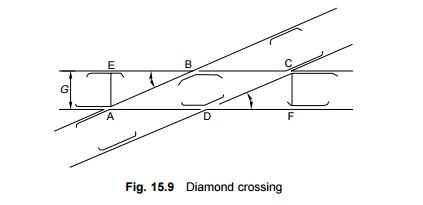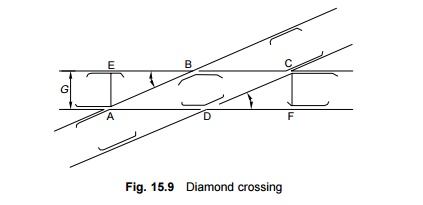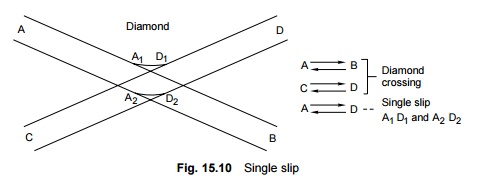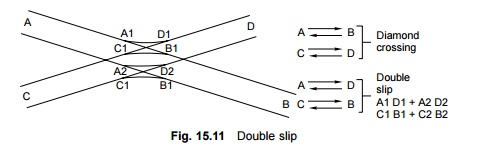Chapter: Civil : Railway Airport Harbour Engineering : Railway Engineering : Track Junctions and Simple Track Layouts
Railway Track Junctions: Diamond Crossing

Diamond Crossing
A diamond crossing is provided when two tracks of either the
same gauge or of different gauges cross each other. It consists of two acute
crossings (A and C) and two obtuse crossings (B and D). A typical diamond
crossing consisting of two tracks of the same gauge crossing each other, is
shown in the Fig. 15.9.
In the layout, ABCD is a rhombus with four equal
sides. The length of the various constituents may be calculated as follows.
EB = DF = AE cot a = GN
AB = BC = G coseca
Diagonal
AC = G coseca/2
Diagonal
BD = G seca/2

It can be seen from the layout
that the length of the gap at points B and D increases as the angle of crossing
decreases. Longer gaps increase the chances of the wheels, particularly of a
small diameter, being deflected to the wrong side of the nose. On Indian
Railways, the flattest diamond crossing permitted for BG and MG routes is 1 in
8.5.
Along with diamond crossings,
single or double slips may also be provided to allow the vehicles to pass from
one track to another.
1 Single Slip and Double Slip
In a diamond crossing, the tracks
cross each other, but the trains from either track cannot change track. Slips
are provided to allow vehicles to change track.
The slip arrangement can be either single slip or double slip.
In single slips, there are two sets of joints, the vehicle from only one
direction can change tracks. In the single slip shown in Fig. 15.10, the train
on track A can change to track D, whereas the train on track C remains on the
same track, continuing onto track D.

In the case of double slips, there are four sets of points,
and trains from both directions can change tracks. In the double slip shown in
Fig. 15.11, the trains on both tracks A and C can move onto either track B or
D.

2 Improvements in the Design of Diamond
Crossings
In order to smoothen the ride
over a diamond crossing, the following improvements are generally made.
(a) Provision
of 25 mm higher check rails
(b) Reduction
in the check rail clearance by 3 mm in the case of obtuse crossings.
Example 15.4 Two BG
tracks cross each other at an angle of 1 in 10. Calculate the important
dimensions of the diamond crossing.
Solution The data given are as follows
(Fig. 15.9):
(i) Number of
the crossing (N) = 10 Gauge (G) = 1.676 m
(ii) N = cot a or 10 = cot a
Therefore,
a = 5 o 42¢ 38¢¢
(iii) EB = DF = AE cota = GN
= 1.676 ×
10 = 16.76 m
(iv) AB = BC = G coseca
=1.676
× 10.05 = 16.85 m
(v) AC = G coseca/2
= 1.676 ×
20.10 = 33.70 m
(vi)
BD = G
sec a/2
= 1.70 m
Related Topics